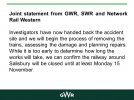Absolutely not, in no circumstances should we attempt to release the brake in an emergency. For a start such an attempt would be ineffective, once an emergency brake application is initiated on these type of units that emergency brake application cannot be released until the low speed relay operates (nominally 3mph, usually more like 5).
It is also very unlikely that all wheels were locked, the WSP system will most likely have been functioning correctly throughout the train and applying sand to the railhead, that system would have been compromised if what I describe in the paragraph above wasn't the case and the driver had actually been able to try to regain wheel rotation - he would have had to fully release the brake. Don't forget this is not a road vehicle. As an experienced driver I know just how long it takes to regain wheel rotation after a wheel lock-up, you are talking maybe more than ten seconds, it can be a surprisingly long time before the wheelsets can regain enough kinetic energy from a very slippery railhead. It also depends on which wheelsets are locked up - on a 15x unit the wheelsets on #1 end bogie are effectively free-rolling, on #2 end bogie both wheelsets are mechanically locked together by the cardan shafts that form the drive train from the transmission. And don't forget this is academic as it's unlikely the train was completely sliding. Each wheelset on #1 bogie has its own WSP blowdown valve which can partially release the brake when wheel slow-up is detected, on #2 bogie there is just one WSP blowdown valve for both wheelsets because they are mechanically locked together. Sand is applied on both sides from the sand delivery pipe on the leading vehicle which is before #2 bogie as is the norm on most DMUs. The WSP system operates totally independently on each vehicle so even if there was a fault on one vehicle there were still two other vehicles it should function on. Sand is only ever deployed from the leading vehicle however, because if all vehicles deployed sand it would bring the risk of the rear-most vehicles standing on so much sand they would be at risk of failing to operate track circuits and therefore wrong-side track circuit failures.
158s (and I'm pretty sure 159s are the same although I don't sign them) don't have enhanced emergency braking, just 9%g. The difference between full service braking and emergency braking is that the 'energise to release' train wires (normally fed for the whole train by the rear-most start battery within the train formation) from train wire 4 to train wires 23 and 25 (and the negative return wire 25) are earthed out in an emergency brake application which provides a guarantee that even if some rogue false-feed could somehow be providing current to one of the 'energise to release' wires 23 or 24, it would be earthed out and therefore nullified. This earthing system proves that the braking system is activating as fully as it is possibly capable of doing.
Edit - Right Away essentially beat me to it.



